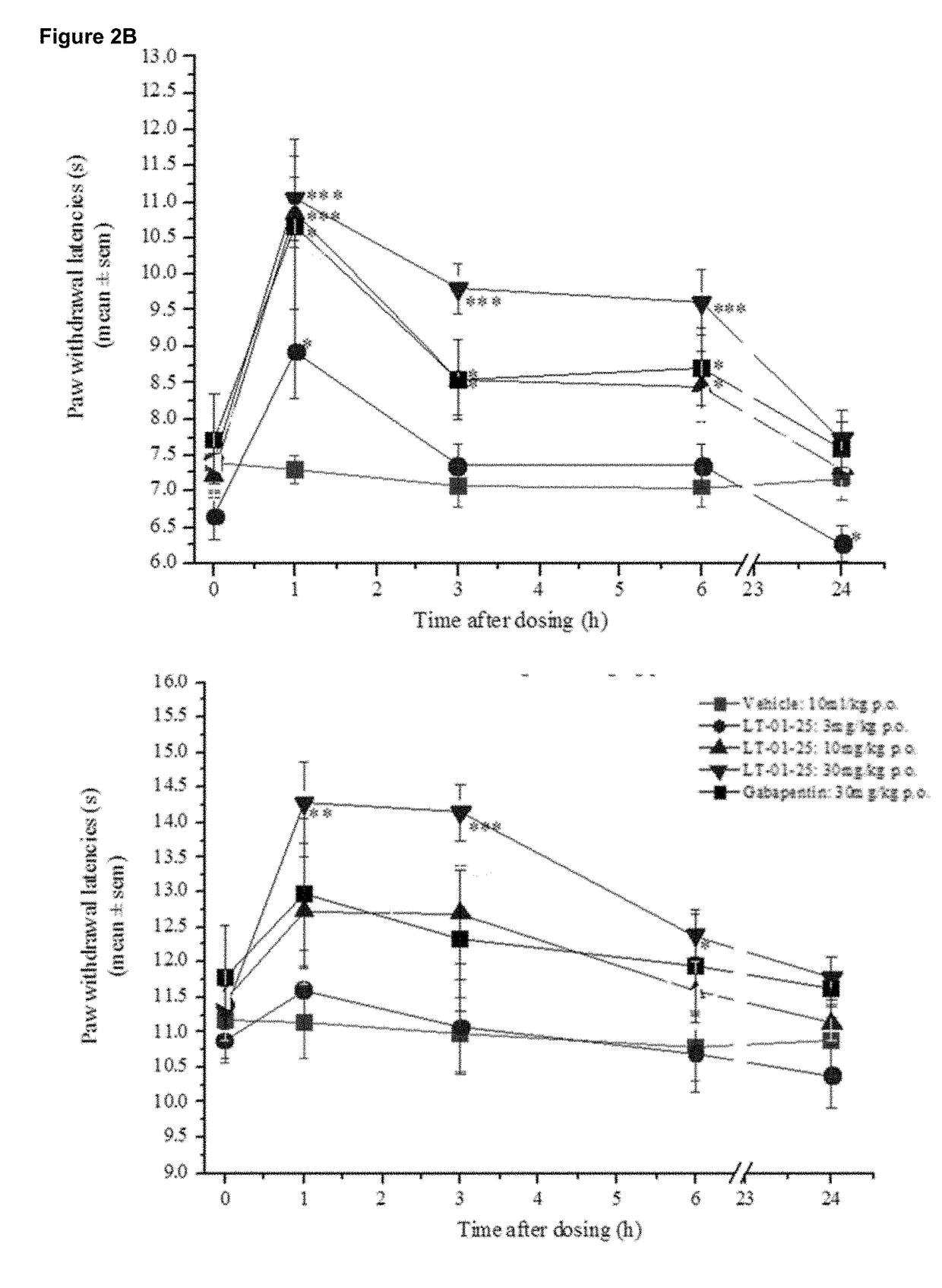Pharmacologically active compounds
a technology of active compounds and compounds, applied in the field of pharmaceutically active compounds, can solve the problems of inability to effectively target the receptors the majority of developments in the pain control field have failed to deliver high efficacy products free of undesirable side effects and safety issues, and the treatment of chronic inflammation or neuropathic pain is still difficul
- Summary
- Abstract
- Description
- Claims
- Application Information
AI Technical Summary
Benefits of technology
Problems solved by technology
Method used
Image
Examples
example 1
synthesis of (4-(hydroxy)-3,5-diisopropylphenyl)(morpholino)methanone (LT-01-25)
Step 1—synthesis of 4-Hydroxy-3-5-diisopropylbenzaldehyde
[0206]
[0207]Hexamethylenetetramine (15.8 g, 56 mmol) was added to a solution of 2,6-Diisopropylphenol (10.4 mL) in glacial acetic acid (50 mL) and H2O (10 mL). The resulting mixture was heated to reflux for 5 minutes and then short path distillation head was introduced and 10 ml of distillate was collected. The solution was allowed to continue refluxing for 6 hrs and the reaction was monitored by TLC. Upon completion of the reaction the solution was cooled to 0° C. and the resulting orange precipitation was isolated and washed with H2O (3×50 mL) to afford product as a pale orange solid (10.3 g, 89% yield). 1H NMR (400 MHz, CDCl3) δ 9.86 (s, 1H), 7.63 (s, 2H), 5.49 (s, 1H), 3.21 (m, 2H), 1.31 (d, J=6.9 Hz, 12H). MS: C13H18O2 requires 206.3, found 206.3.
Step 2—synthesis of 4-(benzyloxy)-3,5-diisopropylbenzaldehyde
[0208]
[0209]To a solution of 4-Hydrox...
example 2
synthesis of (R)-(4-(hydroxy)-3,5-diisopropylphenyl)(2-methylmorpholino)methanone
Synthesis of 4-(benzyloxy)-3,5-diisopropylbenzoyl chloride
[0218]
[0219]4-(benzyloxy)-3,5-diisopropylbenzoic acid (200 mg, 0.6 mmol) was dissolved in DCM (5 mL) under a blanket of N2. Oxalyl chloride (0.12 mL, 0.72 mmol) was added along with DMF (1 drop from a pasture pipette). The reaction mixture was allowed to stir at room temperature for 2 hrs. The reaction was monitored by TLC and upon completion the solvent was removed under vacuum. The product was not isolated and was taken through crude.
Synthesis of (R)-(4-(Benzyloxy)-3,5-diisopropylphenyl)(2-methylmorpholino) methanone
[0220]
[0221](R)-2-Mehtylmorpholine hydrochloride (164 mg, 1.19 mmol) was added to a stirred solution of 4-(benzyloxy)-3,5-diisopropylbenzoyl chloride (264 mg, 0.80 mmol) in DCM (5 mL). Et3N (332 μl, 2.4 mmol) was added and the resulting solution was allowed to stir at room temperature for 1.5 hours. The reaction was monitored by TLC...
example 3
synthesis of (3-Fluoroazetidin-1-yl)(4-hydroxy-3,5-diisopropylphenyl) methanone
Synthesis of 4-(benzyloxy)-3,5-diisopropylphenyl)(3-fluoroazetidin-1-yl)methanone
[0224]
[0225]3-Fluoroazetidine hydrochloride (2500 mg, 2.25 mmol) was added to a stirred solution of 4-(benzyloxy)-3,5-diisopropylbenzoyl chloride (prepared as described in Example 1; 500 mg, 1.5 mmol) in DCM (5 mL). Et3N (597 μl, 4.5 mmol) was added and the resulting solution was allowed to stir at room temperature for 1.5 hours. The reaction was monitored by TLC and upon completion the reaction mixture was quenched with H2O (50 mL) and extracted with EtOAc (3×50 mL). The combined organic extracts were washed with brine, dried over MgSO4 and the solvent was removed under vacuum. The crude product was purified by column chromatography (EtOAc / n-Hexane) to afford the product as a white solid (387.4 mg 70% yield). 1H NMR (400 MHz, CDCl3) δ 7.53-7.34 (m, 6H), 5.36 (dddd, J=56.8, 9.6, 6.2, 3.5 Hz, 1H), 4.58-4.46 (m, 2H), 4.45-4.30 ...
PUM
 Login to View More
Login to View More Abstract
Description
Claims
Application Information
 Login to View More
Login to View More - R&D
- Intellectual Property
- Life Sciences
- Materials
- Tech Scout
- Unparalleled Data Quality
- Higher Quality Content
- 60% Fewer Hallucinations
Browse by: Latest US Patents, China's latest patents, Technical Efficacy Thesaurus, Application Domain, Technology Topic, Popular Technical Reports.
© 2025 PatSnap. All rights reserved.Legal|Privacy policy|Modern Slavery Act Transparency Statement|Sitemap|About US| Contact US: help@patsnap.com



